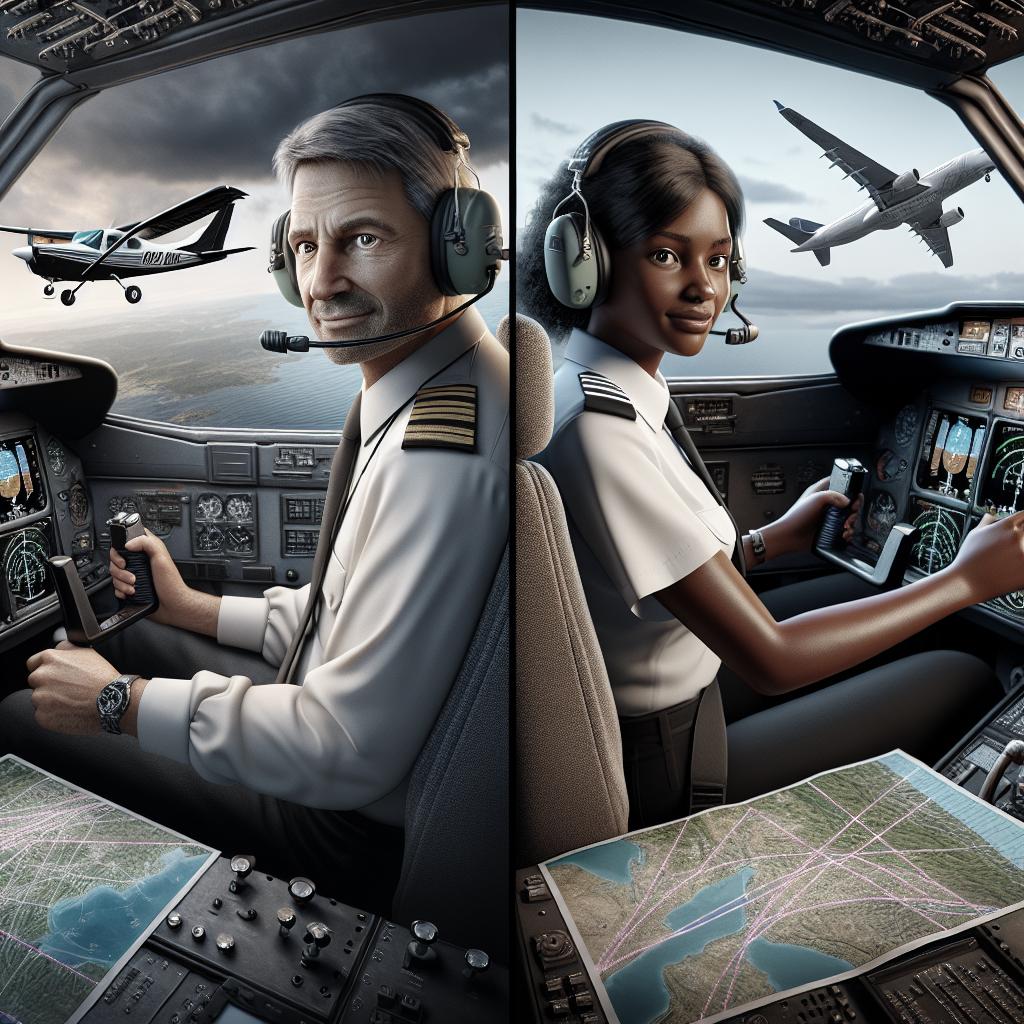Differences Between Private and Commercial Pilots
When considering a career in aviation, understanding the differences between becoming a private pilot and a commercial pilot is essential. Whether flying is a personal passion or a professional aspiration, each path offers distinct roles, responsibilities, and requirements. This blog post explores the nuances that define private and commercial pilots, looking at job duties, earnings, and training. It also delves into the privileges granted by each license, how they affect the types of aircraft one can fly, and the broader implications for recreational versus professional aviation. By understanding these differences, prospective pilots can make informed decisions aligning with their personal goals and career ambitions. Let’s explore these facets in-depth to see which pilot pathway might suit you best.
Commercial or Private Pilot? Which Type of Pilot Would You Like to Be?
Differences Between Private and Commercial Pilots
One of the first distinctions between private and commercial pilots is their purpose of flight. Private pilots typically fly for leisure or personal travel and cannot receive compensation for their services. In contrast, commercial pilots are qualified to be remunerated for their pilot duties, operating flights for various commercial purposes such as transporting cargo or passengers.
The environments in which these pilots operate also differ substantially. Private pilots often enjoy more flexible flying conditions. They can leisurely explore skies at their discretion while adhering to safety standards. Commercial pilots usually work under stricter schedules and regulations imposed by aviation agencies and their employers, as they must prioritize passenger safety and aircraft efficiency.
Job Duties and Responsibilities
Private pilots’ responsibilities center on ensuring the safety of any flight they choose to undertake. This involves pre-flight checks and navigation planning to secure a smooth, efficient journey. The enjoyment of flying personal routes is typically the main focus rather than duty-related tasks.
Conversely, commercial pilots are responsible for comprehensive planning, operating commercial flights, and ensuring passenger safety throughout the journey. They perform systematic inspections, coordinate with air traffic control, manage passenger protocols, and deal with various logistical challenges.
Salary and Earnings
Private pilots do not earn from flying unless they attain further certifications. Flying as a private pilot is generally a cost-incurring hobby, not a profitable one. Thus, they pursue other professions that allow them the financial means to support their flight endeavors.
Commercial pilots, however, earn a viable income from flying. Earnings vary based on the type of aircraft operated, employer, and experience level. Many commercial pilots build careers with airlines or cargo companies, boasting competitive salaries and benefits.
Training Requirements and Certifications
To become a private pilot, one requires a private pilot certificate, which involves passing the necessary ground school and flight training. This includes a minimum of 35 hours of flight time, though perfection often demands more practice.
Commercial pilots require additional certifications and rigorous training, acquiring a commercial pilot license as well as an instrument rating. They often undergo more than 250 hours of flight training to handle complex flying situations professionally.
Privileges and Limitations of Private Pilots – And the Difference From a Recreational Pilot License
Types of Aircraft They Can Fly
Private pilots are permitted to fly single-engine aircraft under visual flight rules (VFR). This encompasses a broad range of small airplanes suitable for personal journeys, making it ideal for those who prefer leisure flying or personal transport.
However, they are limited from piloting larger, more complex aircraft, which are typically operated by commercial aviators. This limitation also applies to night flying unless they obtain an IFR (Instrument Flight Rules) rating.
Restrictions on Carrying Passengers and Cargo
While private pilots can carry passengers, they cannot do so for hire or charge. They are also precluded from transporting cargo commercially. The cost-sharing provisions allow them to share some flight expenses with passengers, but even then, the flight must remain non-commercial.
Unlike private pilots, commercial pilots legally operate flights for compensation, granting them the authority to transport passengers and cargo as part of their professional duties.
Leisure and Recreational Flying
Leisure flying is the hallmark of the private pilot. They enjoy flying to new destinations, experiencing the thrill and freedom of aviation without the constraints of commercial obligations. This form of flying caters to those with a passion for soaring skies privately.
Since private pilots typically fly small, personal aircraft, their flying is often limited to good weather conditions and shorter distances, aligning with recreational flying goals.
A Private Pilot is Not the Same as a Recreational Pilot or a Sport Pilot
Although similar, a private pilot’s certificate is different from a recreational pilot license. The latter comes with more restrictions concerning the number of passengers and airspace access, with reduced requirements in training and experience.
Additionally, a sport pilot license, which is even more limited than a recreational one, caters to ultralight aircraft and has its parameters, designed explicitly for those who wish to fly light sport aircraft.
Privileges and Responsibilities of Commercial Aviation Pilots
Ability to Fly Larger and More Complex Aircraft
Commercial pilots are certified to operate more complex, larger aircraft, often including multi-engine planes. Their training enables them to handle sophisticated instrumentation and technologies, increasing the scope of flights they can tackle.
Expertise in larger aircraft readiness allows commercial pilots to embark on extensive national and international flights, equipped to navigate the many intricacies of commercial airspace.
Responsibilities for Transporting Passengers or Cargo
A core responsibility for commercial pilots is the safe transportation of freight and passengers. Their role extends beyond merely flying the plane; it encompasses ensuring passenger comfort, handling emergencies, and stringent adherence to safety guidelines.
Their duties require exceptional organizational skills, including coordination with crews and ground staff, confirming that all operations align with scheduled timelines.
Additional Training and Certifications Required
Aside from the extensive training for a commercial license, aspiring commercial pilots must earn an instrument rating, and often, ratings for particular aircraft types. This continuous learning pathway ensures pilots adapt to evolving technologies and methodologies.
Additional certifications like an ATP (Airline Transport Pilot) certificate are often pursued by those looking to climb the career ladder into airline captaincy, necessitating further operational responsibilities and command skills.
Should You Get Your Commercial Pilot License? Or Your Private Pilot License?
Factors to Consider When Deciding Between Private and Commercial Pilot Careers
Deciding between private and commercial pilot licenses hinges on personal interests and long-term goals. Enthusiasts who cherish the liberty of flight for personal satisfaction might lean toward a private pilot license, enjoying the freedom it accords without commercial pressures.
In contrast, those seeking a professional aviation career would benefit from pursuing a commercial pilot license, tapping into opportunities that demand regular flying with defined responsibilities.
Personal Goals and Preferences
Your personal ambitions should guide your decision. A private pilot’s path suits those seeking joyrides, family fly-ins, or spontaneous weekend adventures, providing a fulfilling leisure pursuit.
Conversely, professional aspirations of commanding the skies, managing vast aircraft, and pursuing advancement within airlines might push one toward the rigor and rewards of commercial piloting.
Opportunities for Career Advancement
Career growth is more prominent as a commercial pilot. With experience and specialization, pilots can ascend from co-pilots to captains, and even into managerial positions within aviation companies, enhancing their professional presence.
A private pilot license, however rewarding on a personal level, offers limited career advancement unless accompanied by additional qualifications or a shift towards aviation business sectors.
Job Market and Industry Trends
The aviation industry continually evolves with technology and passenger demands. Currently, commercial aviation enjoys growth, propelled by burgeoning demand for air travel, positioning commercial pilots in a lucrative, albeit competitive, marketplace.
Private aviation remains steady, with passion pilots perpetuating its relevance, though its expansion is less pronounced compared to the commercial sector, reflecting its niche market and individualized appeal.
Future Prospects: Private Pilot Certificate vs. Commercial Pilot Certificate – It’s All Up to You.
Ultimately, choosing between a private or commercial pilot license depends on your own aspirations, lifestyle, and vision. Each offers unique privileges and responsibilities that cater to differing flying experiences. Whether for leisure or a lifelong career, the skies possess adventures and challenges suited to every pilot’s dream. By understanding the specific distinctions outlined above, you can better align your passion for aviation with the most enriching pathway, ensuring your journey among the clouds aligns with your ultimate goals.
| Aspect | Private Pilot | Commercial Pilot |
|---|---|---|
| Purpose of Flight | Personal and leisure | Commercial and professional |
| Certification | Private Pilot License (PPL) | Commercial Pilot License (CPL) with additional ratings |
| Duties | Flight safety for personal journeys | Comprehensive flight operation and passenger care |
| Earnings | Non-revenue-generating | Primary source of income |
| Aircraft | Single-engine, non-complex | Larger, complex multi-engine |
| Passenger & Cargo | No hire or remuneration | Commercial transportation permissible |


